Research on Regional Carbon Emission Reduction in the Beijing–Tianjin–Hebei Urban Agglomeration Based on System Dynamics: Key Factors and Policy Analysis
Abstract
:1. Introduction
2. Methodology
2.1. Study Area
2.1.1. BTHUA Carbon Emission Status
2.2. Model Structure
2.3. Flow Diagram Description
2.3.1. Economic and Population Subsystem
2.3.2. Traffic Subsystem
2.3.3. Industrial Production Subsystem
2.3.4. Electric Power Generation Subsystem
2.3.5. Carbon Sink Subsystem
2.4. The BTHUA Data
2.5. Model Test
2.6. Evaluating Key Influencing Factors Based on Sensitivity Analysis
2.7. Scenario Settings
3. Empirical Results and Analysis
3.1. Results of Sensitivity Analysis and Key Influencing Factors
3.2. Scenario Analysis of Different Emission Reduction Measures
4. Conclusions and Policy Implications
- (1)
- The industrial structure is the key influencing factor for carbon emissions in the BTHUA. The impact of population growth on carbon emissions is relatively limited, while economic growth can to some extent affect carbon emissions. The impact of energy structure adjustment and technological innovation investment on carbon emissions is relatively significant.
- (2)
- By implementing emission reduction policies, carbon emissions can be effectively reduced. Among them, integrated policies have the best emission reduction effect. Compared with no implementation of any policies, by 2035, integrated policies can reduce CO2 emissions by 43.68%. Adjusting the energy structure has the best emission reduction effect among the four single-policy scenarios (SDS, ISAS, ESAS, and TIS). Compared with no implementation of any policies, this policy can reduce CO2 emissions by 27.22%.
- (3)
- By implementing emission reduction policies, carbon peak time can be reached much earlier. Except for economic and social development policies, the implementation of other policies can achieve carbon peak targets by 2030. Among them, integrated policies can achieve carbon peak targets as early as possible, and the carbon peak amount is the lowest. Among the four single-policy scenarios (SDS, ISAS, ESAS, and TIS), increasing investment in technological innovation is the best strategy to reach carbon peak targets at the earliest.
- (4)
- The carbon emission intensity of the BTHUA maintained a slow downward trend from 2010 to 2019. Based on current policies (i.e., the BS), it is predicted in this study that the carbon emission intensity will continue to decline in the future. By implementing emission reduction policies, we can further reduce the carbon emission intensity and promote a comprehensive green and low-carbon transformation of the economy and society. Compared with not implementing any policies, integrated policies can reduce carbon emission intensity by 53.26% by 2035. Adjusting the energy structure has the best effect among the four single-policy scenarios (SDS, ISAS, ESAS, and TIS). Compared with not implementing any policies, this policy can reduce CO2 emissions intensity by 27.05%.
- (5)
- For various evaluation indicators, integrated policies always have the best effect. However, from the simulation data, the evidence shows that the carbon reduction effects of integrated policies are not a simple summation of the emission reduction effects of other single-policy measures. In addition, the simultaneous implementation of multiple policy measures also means investing more human resources, material resources, and financial resources. Therefore, policies should be scientifically and reasonably formulated and implemented under local conditions, and policies should not be blindly added in pursuit of low CO2 emissions. This paper provides the optimal emission reduction measures based on different emission reduction indicators, providing some suggestions and support for policy formulation.
Author Contributions
Funding
Data Availability Statement
Conflicts of Interest
Appendix A
| Equation | Unit |
|---|---|
| Afforestation investment = 0.0287641 × GDP − 672.059 | Billion CNY |
| Bus = INTEG (Bus incremental value, 46,054) | Vehicle Unit |
| Bus incremental value = 15.5799 × Investment in transport infrastructure − 6512.35 | Vehicle Unit |
| BUSCE = Bus × BUSCEC | Million Tons |
| BUSCEC = 1.99386 × 10−4 × EXP ((−2.04312 × 10−4) × Technology investment) | - |
| Car = INTEG (Car incremental value, 9.2874 × 106) | Vehicle Unit |
| Car incremental value = 1.98481 × Per Capita GDP + 1.38588 × 106 | Vehicle Unit |
| Carbon intensity = Total carbon emissions/GDP | Million tons/Billion CNY |
| Carbon sink = Forest carbon sink + Grassland carbon sink + Ocean carbon sequestration flux | Million Tons |
| CARCE = CARCEC × Car | Million Tons |
| CARCEC = 1.46597 × 10−6 × EXP((−1.96062 × 10−4) × Technology investment) | - |
| DCE = Residential energy consumption × DCEC | Million Tons |
| DCEC = 0.0169 | - |
| Energy consumption in industrial production processes = 0.245 × Industrial production output value + 0.764 × Energy consumption in the secondary industry | 104 × Tce |
| Energy consumption in the secondary industry = 6851.73 × LN(Output value of the secondary industry) − 36,319.7 | 104 × Tce |
| Forest area incremental value = 7.22399 × 10−3 × Afforestation investment − 1.47019 | 104 × Hectare |
| Forest carbon sequestration factor = 1.6 | - |
| Forest carbon sink = Forest carbon sequestration factor × Total forest area | Million Tons |
| Fossil energy generation = 10,527 × ICOFEPG − 3.59253 × 107 | KW |
| GDP = INTEG (GDP incremental value, 39,798.40) | Billion CNY |
| GDP growth rate = WITH LOOKUP (Time, ([(0, 0) − (3000, 10)], (2010, 0.173064), (2011, 0.0955149), (2012, 0.082012), (2013, 0.062087), (2014, 0.0558291), (2015, 0.0795332), (2016, 0.0892899), (2017, 0.0820749), (2018, 0.069849), (2019, 0.0198739), (2020, 0.0515417), (2021, 0.0485604), (2022, 0.0457515), (2023, 0.0431052), (2024, 0.0406118), (2025, 0.0382627), (2026, 0.0360495), (2027, 0.0339643), (2028, 0.0319997), (2029, 0.0301488), (2030, 0.0284049), (2031, 0.0267619), (2032, 0.0252139), (2033, 0.0237555), (2034, 0.0223814), (2035, 0.0210868))) | - |
| GDP incremental value = GDP × GDP growth rate | Billion CNY |
| Grassland area = 0.552534 | 104 × Hectare |
| Grassland carbon sequestration factor = 1.3 | - |
| Grassland carbon sink = Grassland carbon sequestration factor × Grassland area | Million Tons |
| ICFFEPGIV = IF THEN ELSE (Time <= 2015, 280, 0.140532 × Proportion of fossil fuels × Energy consumption in the secondary industry − 3561.93) | 104 × Tce |
| ICFNFEPGIV = IF THEN ELSE (Time <= 2015, 330, 0.702402 × Energy consumption in the secondary industry × “Proportion of non-fossil fuels” − 2880.87) | 104 × Tce |
| ICOFEPG = INTEG (ICFFEPGIV, 4918) | KW |
| ICONFEPG = INTEG (ICFNFEPGIV, 0) | KW |
| Industrial production output value = Output value of the secondary industry × Proportion of industrial production output value | Billion CNY |
| Investment in transport infrastructure = 709.837 × LN(GDP) − 7123.11 | Billion CNY |
| IPPCE = IF THEN ELSE (Time = 2017, 45,642.2, IPPCEC × Energy consumption in industrial production processes) | Million Tons |
| IPPCEC = 1.80874 × 10−2 × EXP ((−1.67338 × 10−5) × Technology investment) | - |
| Net carbon emissions = Total carbon emissions − carbon sink | Million Tons |
| NEVCE = New energy vehicles × NEVCEC | Million Tons |
| NEVCEC = 9.48802 × 10−5 × EXP ((−1.17821 × 10−4) × Technology investment) | - |
| New energy vehicles = INTEG (New energy vehicles incremental value, 43,299) | Vehicle Unit |
| New energy vehicles incremental value = 4.57677 × Technology investment + 227.423 | Billion CNY |
| OCE = WITH LOOKUP (Time, ([(2010, 0) − (2035, 7000)], (2010, 6046),(2011, 5871), (2012, 6793.14), (2013, 5708.13), (2014, 5732.44), (2015, 5895.85), (2016, 5817.77), (2017, 5564.29), (2018, 4822.63), (2019, 4654.11), (2020, 4839.97), (2021, 4685.32), (2022, 4530.67), (2023, 4376.02), (2024, 4221.38), (2025, 4066.73), (2026, 3912.08), (2027, 3757.43), (2028, 3602.78), (2029, 3448.13), (2030, 3293.49), (2031, 3138.84), (2032, 2984.19), (2033, 2829.54), (2034, 2674.89), (2035, 2520.24))) | - |
| Ocean carbon sequestration flux = 8.55 | - |
| Output value of the secondary industry = GDP × Proportion of secondary industry | Billion CNY |
| Per Capita GDP = GDP/Total population | Billion CNY/104 |
| PGCE = Fossil energy generation × PGCEC | Million Tons |
| PGCEC = 2.16474 × 10−5 × EXP ((−2.44594 × 10−4) × Technology investment) | - |
| Population growth rate = WITH LOOKUP (Time, ([(2010, −0.0009) − (2030, 0.03282)], (2010, 0.0152), (2011, 0.01473), (2012, 0.01389), (2013, 0.01214), (2014, 0.00816), (2015, 0.00763158), (2016, 0.00608), (2017, 0.00535), (2018, 0.0043), (2019, 0.00312), (2020, 0.00266), (2021, 0.001538), (2022, 0.00086), (2023, 0.000292), (2024, −0.00016), (2025, −0.00051), (2026, −0.00075), (2027, −0.00087), (2028, −0.00089), (2029, −0.00079), (2030, −0.00059), (2031, −0.00027), (2032, 0.000155), (2033, 0.000692), (2034, 0.00134), (2035, 0.002098))) | - |
| Population incremental value = Total population × Population growth rate | 104 |
| Proportion of fossil fuels = 1 − “Proportion of non-fossil fuels” | - |
| Proportion of industrial production output value = WITH LOOKUP (Time, ([(0, 0) − (3000, 10)], (2010, 0.86477), (2011, 0.865141), (2012, 0.863427), (2013, 0.860274), (2014, 0.854771), (2015, 0.846436), (2016, 0.849644), (2017, 0.840986), (2018, 0.832658), (2019, 0.837231), (2020, 0.830611), (2021, 0.826807), (2022, 0.823003), (2023, 0.819199), (2024, 0.815395), (2025, 0.811591), (2026, 0.807786), (2027, 0.803982), (2028, 0.800178),(2029, 0.796374), (2030, 0.79257), (2031, 0.788766), (2032, 0.784962), (2033, 0.781158), (2034, 0.777353), (2035, 0.773549))) | - |
| “Proportion of non-fossil fuels” = WITH LOOKUP (Time, ([(2010, 0) − (2035, 1)], (2010, 0.111849), (2011, 0.119596), (2012, 0.119371), (2013, 0.139841), (2014, 0.138108), (2015, 0.133127), (2016, 0.142367), (2017, 0.149612), (2018, 0.14858), (2019, 0.153829), (2020, 0.160112), (2021, 0.164563), (2022, 0.169015), (2023, 0.173466), (2024, 0.177918), (2025, 0.182369), (2026, 0.186821), (2027, 0.191272), (2028, 0.195724), (2029, 0.200175), (2030, 0.204627), (2031, 0.209079), (2032, 0.21353), (2033, 0.217982), (2034, 0.222433), (2035, 0.226885))) | - |
| Proportion of secondary industry = WITH LOOKUP (Time, ([(2010, 0) − (2060, 0.4)], (2010, 0.37598), (2011, 0.37688), (2012, 0.369726), (2013, 0.356855), (2014, 0.349216), (2015, 0.329196), (2016, 0.318932), (2017, 0.30684), (2018, 0.294019), (2019, 0.284191), (2020, 0.281437), (2021, 0.29024), (2022, 0.285663), (2023, 0.281515), (2024, 0.27773), (2025, 0.274251), (2026, 0.271036), (2027, 0.26805), (2028, 0.265266), (2029, 0.262658), (2030, 0.260208), (2031, 0.257098), (2032, 0.254294), (2033, 0.251491), (2034, 0.248687), (2035, 0.245883))) | - |
| Rail transit = INTEG (Rail transit incremental value, 2755) | Vehicle Unit |
| Rail transit incremental value = 1.40466 × Investment in transport infrastructure − 275.37 | Billion CNY |
| Residential energy consumption = 2.8062 × Total population − 25,203.9 | 104 × Tce |
| RTCE = Rail transit × RTCEC | Million Tons |
| RTCEC = 889,396 ×10−4 × EXP ((−1.9907910−4) × Technology investment) | - |
| Taxi = INTEG (Taxi incremental value, 144,602) | Vehicle Unit |
| Taxi incremental value = 0.782137 × Investment in transport infrastructure + 1050.85 | Billion CNY |
| TAXICE = Taxi × TAXICEC | Million Tons |
| TAXICEC = 0.0000501074 × EXP((−3.06312 × 10−5) × Technology investment) | - |
| TCE = BUSCE + TAXICE + TRUCKCE + NEVCE + CARCE + RTCE | Million Tons |
| Technology investment = GDP × Technology investment ratio | Billion CNY |
| Technology investment ratio = WITH LOOKUP (Time, ([(2010, 0) − (2035, 0.05)], (2010, 0.0303237), (2011, 0.0307531), (2012, 0.0326447), (2013, 0.034255), (2014, 0.0348397), (2015, 0.0361981), (2016, 0.0359043), (2017, 0.0341271), (2018, 0.0347138), (2019, 0.037221), (2020, 0.0372676), (2021, 0.0373141), (2022, 0.0373607), (2023, 0.0374072), (2024, 0.0374538), (2025, 0.0375003), (2026, 0.0375469), (2027, 0.0375935), (2028, 0.03764), (2029, 0.0376866), (2030, 0.0377331), (2031, 0.0377797), (2032, 0.0378262), (2033, 0.0378728), (2034, 0.0379193), (2035, 0.0379659))) | - |
| Total carbon emissions = TCE + OCE + PGCE + IPPCE+ DCE | Million Tons |
| Total forest area = INTEG (Forest area incremental value, 483.96) | 104 × Hectare |
| Total population = INTEG (Population incremental value, 10,454.8) | 104 |
| Truck = INTEG (Truck incremental value, 1.6004 × 106) | Vehicle Unit |
| Truck incremental value = 0.651127 × GDP + 164,883 | Billion CNY |
| TRUCKCE = Truck × TRUCKCEC | Million Tons |
| TRUCKCEC = 7.15537 ×10−6 × EXP ((−9.50746 × 10−5) × Technology investment) | - |
References
- IPCC. The Ocean and Cryosphere in a Changing Climate; Cambridge University Press: Cambridge, UK; New York, NY, USA, 2022. [Google Scholar]
- Thackeray, S.J.; Robinson, S.A.; Smith, P.; Bruno, R.; Kirschbaum, M.U.F.; Bernacchi, C.; Byrne, M.; Cheung, W.; Cotrufo, M.F.; Gienapp, P.; et al. Civil disobedience movements such as School Strike for the Climate are raising public awareness of the climate change emergency. Glob. Chang. Biol. 2020, 26, 1042–1044. [Google Scholar] [CrossRef] [PubMed]
- IPCC. Climate Change 2022: Impacts, Adaptation and Vulnerability; Cambridge University Press: Cambridge, UK; New York, NY, USA, 2022; pp. 121–196. [Google Scholar]
- Cai, L.; Luo, J.; Wang, M.; Guo, J.; Duan, J.; Li, J.; Li, S.; Liu, L.; Ren, D. Pathways for municipalities to achieve carbon emission peak and carbon neutrality: A study based on the LEAP model. Energy 2023, 262, 125435. [Google Scholar] [CrossRef]
- Li, R.; Yu, Y.H.; Cai, W.G.; Liu, Q.Q.; Liu, Y.; Zhou, H.A. Interprovincial differences in the historical peak situation of building carbon emissions in China: Causes and enlightenments. J. Environ. Manag. 2023, 332, 117347. [Google Scholar] [CrossRef] [PubMed]
- Le Quéré, C.; Korsbakken, J.I.; Wilson, C.; Tosun, J.; Andrew, R.; Andres, R.J.; Canadell, J.G.; Jordan, A.; Peters, G.P.; van Vuuren, D.P. Drivers of declining CO2 emissions in 18 developed economies. Nat. Clim. Chang. 2019, 9, 213–217. [Google Scholar] [CrossRef]
- El Anshasy, A.A.; Katsaiti, M.S. Energy intensity and the energy mix: What works for the environment? J. Environ. Manag. 2014, 136, 85–93. [Google Scholar] [CrossRef]
- Erdoğan, S.; Yıldırım, S.; Yıldırım, D.Ç.; Gedikli, A. The effects of innovation on sectoral carbon emissions: Evidence from G20 countries. J. Environ. Manag. 2020, 267, 110637. [Google Scholar] [CrossRef] [PubMed]
- Papadis, E.; Tsatsaronis, G. Challenges in the decarbonization of the energy sector. Energy 2020, 205, 118025. [Google Scholar] [CrossRef]
- Bruninx, K.; Ovaere, M. COVID–19, Green Deal and recovery plan permanently change emissions and prices in EU ETS Phase IV. Nat. Commun. 2022, 13, 1165. [Google Scholar] [CrossRef]
- Green, J.F. Does carbon pricing reduce emissions? A review of ex-post analyses. Environ. Res. Lett. 2021, 16, 043004. [Google Scholar] [CrossRef]
- Stainforth, D.A. ‘Polluter pays’ policy could speed up emission reductions and removal of atmospheric CO2. Nature 2021, 596, 346–347. [Google Scholar] [CrossRef]
- Wang, H.G.; Xiao, L.X.; Liao, B. Simulation of China’s carbon emission reduction path based on system dynamics. J. Nat. Resour. 2022, 37, 1352–1369. [Google Scholar] [CrossRef]
- Trail, M.A.; Tsimpidi, A.P.; Liu, P.; Tsigaridis, K.; Hu, Y.T.; Rudokas, J.R.; Miller, P.J.; Nenes, A.; Russell, A.G. Impacts of potential CO2–reduction policies on air quality in the United States. Environ. Sci. Technol. 2015, 49, 5133–5141. [Google Scholar] [CrossRef] [PubMed]
- Wang, Q.; Wang, X.W.; Li, R.R. Does urbanization redefine the environmental Kuznets curve? An empirical analysis of 134 Countries. Sustain. Cities Soc. 2022, 76, 103382. [Google Scholar] [CrossRef]
- Wang, Q.; Sun, J.; Pata, U.K.; Li, R.R.; Kartal, M.T. Digital economy and carbon dioxide emissions: Examining the role of threshold variables. Geosci. Front. 2023, 101644. [Google Scholar] [CrossRef]
- Li, R.R.; Wang, Q.; Liu, Y.; Jiang, R. Per-capita carbon emissions in 147 countries: The effect of economic, energy, social, and trade structural changes. Sustain. Prod. Consum. 2021, 27, 1149–1164. [Google Scholar] [CrossRef]
- Wang, Q.; Zhang, F.Y.; Li, R.R. Revisiting the environmental kuznets curve hypothesis in 208 counties: The roles of trade openness, human capital, renewable energy and natural resource rent. Environ. Res. 2023, 216, 114637. [Google Scholar] [CrossRef] [PubMed]
- Wang, Q.; Wang, L.L.; Li, R.R. Trade openness helps move towards carbon neutrality—Insight from 114 countries. Sustain. Dev. 2023. [Google Scholar] [CrossRef]
- Wang, Q.; Zhang, F.Y.; Li, R.R. Free trade and carbon emissions revisited: The asymmetric impacts of trade diversification and trade openness. Sustain. Dev. 2023. [Google Scholar] [CrossRef]
- Xiang, N.; Xu, F. Optimization path simulation of carbon emission peak in Beijing–based on structure and efficiency improvement. J. Beijing Univ. Technol. (Soc. Sci. Ed.) 2022, 22, 68–87. [Google Scholar]
- Wang, Y.; Bi, Y.; Wang, E.D. Scene prediction of carbon emission peak and emission reduction potential estimation in Chinese industry. China Popul. Resour. Environ. 2017, 27, 131–140. [Google Scholar]
- Ofori, E.K.; Li, J.; Gyamfi, B.A.; Opoku-Mensah, E.; Zhang, J. Green industrial transition: Leveraging environmental innovation and environmental tax to achieve carbon neutrality. Expanding on STRIPAT model. J. Environ. Manag. 2023, 343, 118121. [Google Scholar] [CrossRef] [PubMed]
- Handayani, K.; Anugrah, P.; Goembira, F.; Overland, I.; Suryadi, B.; Swandaru, A. Moving beyond the NDCs: ASEAN pathways to a net–zero emissions power sector in 2050. Appl. Energy 2022, 311, 118580. [Google Scholar] [CrossRef]
- Mirzaei, M.; Bekri, M. Energy consumption and CO2 emissions in Iran, 2025. Environ. Res. 2017, 154, 345–351. [Google Scholar] [CrossRef]
- Xu, N.; Ding, S.; Gong, Y.D.; Bai, J. Forecasting Chinese greenhouse gas emissions from energy consumption using a novel grey rolling model. Energy 2019, 175, 218–227. [Google Scholar] [CrossRef]
- Chen, X.; Shuai, C.; Wu, Y.; Zhang, Y. Analysis on the carbon emission peaks of China’s industrial, building, transport, and agricultural sectors. Sci. Total Environ. 2019, 709, 135768. [Google Scholar] [CrossRef] [PubMed]
- Gao, G.L.; Wen, Y.; Wang, L.; Xu, R.N. Study on carbon peak of urban clusters based on analysis of influencing factors of carbon emissions. Bus. Manag. J. 2023, 45, 39–58. [Google Scholar]
- Fang, G.C.; Tian, L.X.; Fu, M.; Sun, M.; Du, R.J.; Liu, M.H. Investigating carbon tax pilot in YRD urban agglomerations–Analysis of a novel ESER system with carbon tax constraints and its application. Appl. Energy 2017, 194, 635–647. [Google Scholar] [CrossRef]
- Zhang, Z.F.; Zhang, D. Spatial relatedness of CO2 emission and carbon balance zoning in Beijing Tianjin Hebei counties. China Environ. Sci. 2023, 43, 2057–2068. [Google Scholar]
- Lian, J.H.; Lauvaux, T.; Utard, H.; Breon, F.M.; Broquet, G.; Ramonet, M.; Laurent, O.; Albarus, I.; Cucchi, K.; Ciais, P. Assessing the effectiveness of an urban CO2 monitoring network over the Paris region through the COVID–19 lockdown natural experiment. Environ. Sci. Technol. 2022, 56, 2153–2162. [Google Scholar] [CrossRef]
- Wang, C.; Zhan, J.Y.; Bai, Y.P.; Chu, X.; Zhang, F. Measuring carbon emission performance of industrial sectors in the Beijing–Tianjin–Hebei region, China: A stochastic frontier approach. Sci. Total Environ. 2019, 685, 786–794. [Google Scholar] [CrossRef]
- Qudrat–Ullah, H.; Seong, B.S. How to do structural validity of a system dynamics type simulation model: The case of an energy policy model. Energy Policy 2010, 38, 2216–2224. [Google Scholar] [CrossRef]
- Xiao, S.J.; Dong, H.J.; Geng, Y.; Tian, X. Low carbon potential of urban symbiosis under different municipal solid waste sorting modes based on a system dynamic method. Resour. Conserv. Recycl. 2022, 179, 106108. [Google Scholar] [CrossRef]
- Sim, J.; Sim, J. The effect of new carbon emission reduction targets on an apartment building in South Korea. Energy Build. 2016, 127, 637–647. [Google Scholar] [CrossRef]
- Roberts, S.H.; Foran, B.D.; Axon, C.J.; Warr, B.S.; Goddard, N.H. Consequences of selecting technology pathways on cumulative carbon dioxide emissions for the United Kingdom. Appl. Energy 2018, 228, 409–425. [Google Scholar] [CrossRef]
- Wang, Y.J.; Lin, X. A review of climate change and its impact and adaptation in Beijing-Tianjin-Hebei urban agglomeration. Clim. Chang. Res. 2022, 18, 743–755. [Google Scholar]
- Wang, Z.B.; Liang, L.W.; Sun, Z.; Wang, X.M. Spatiotemporal differentiation and the factors influencing urbanization and ecological environment synergistic effects within the Beijing-Tianjin-Hebei urban agglomeration. J. Environ. Manag. 2019, 243, 227–239. [Google Scholar] [CrossRef]
- Yan, X.H.; Gao, D.; Li, Y. Thoughts and Countermeasures on Promoting Energy Revolution in the Beijing–Tianjin–Hebei Region. Engineering 2021, 23, 24–31. [Google Scholar] [CrossRef]
- Fankhauser, S.; Smith, S.M.; Allen, M.; Axelsson, K.; Hale, T.; Hepburn, C.; Kendall, J.M.; Khosla, R.; Lezaun, J.; Mitchell-Larson, E.; et al. The meaning of net zero and how to get it right. Nat. Clim. Chang. 2022, 12, 15–21. [Google Scholar] [CrossRef]
- Mostafaeipour, A.; Bidokhti, A.; Fakhrzad, M.B.; Sadegheih, A.; Mehrjerdi, Y.Z. A new model for the use of renewable electricity to reduce carbon dioxide emissions. Energy 2022, 238, 121602. [Google Scholar] [CrossRef]
- Yang, H.H.; Li, X.; Ma, L.W.; Li, Z. Using system dynamics to analyse key factors influencing China’s energy-related CO2 emissions and emission reduction scenarios. J. Clean. Prod. 2021, 320, 128811. [Google Scholar] [CrossRef]
- Bernardo, G.; D’Alessandro, S. Systems–dynamic analysis of employment and inequality impacts of low–carbon investments. Environ. Innov. Soc. Transit. 2016, 21, 123–144. [Google Scholar] [CrossRef]
- Li, W.; An, C.L.; Lu, C. The assessment framework of provincial carbon emission driving factors: An empirical analysis of Hebei Province. Sci. Total Environ. 2018, 637, 91–103. [Google Scholar] [CrossRef] [PubMed]
- Dai, T.J.; An, B.C.; Wang, W.J. Path analysis of coordinated development of resource, environment and economy in Beijing–Tianjing–Hebei region. J. Ecol. Rural Environ. 2020, 36, 731–740. [Google Scholar]
- Yang, Y.; He, F.; Ji, J.P.; Liu, X. Peaking carbon emissions in a megacity through economic restructuring: A case study of Shenzhen, China. Energies 2022, 15, 6932. [Google Scholar] [CrossRef]
- Liu, Y.R.; Tang, L.; Liu, G.F. Carbon dioxide emissions reduction through technological innovation: Empirical evidence from Chinese provinces. Int. J. Environ. Res. Public Health 2022, 19, 9543. [Google Scholar] [CrossRef]
- Jia, P.R.; Li, K.; Shao, S. Choice of technological change for China’s low-carbon development: Evidence from three urban agglomerations. J. Environ. Manag. 2018, 206, 1308–1319. [Google Scholar] [CrossRef]
- Qin, H.T.; Huang, Q.H.; Zhang, Z.W.; Lu, Y.; Li, M.C.; Xu, L.; Chen, Z.J. Carbon dioxide emission driving factors analysis and policy implications of Chinese cities: Combining geographically weighted regression with two-step cluster. Sci. Total Environ. 2019, 684, 413–424. [Google Scholar] [CrossRef]
- Gu, R.D.; Li, C.F.; Li, D.D.; Yang, Y.Y.; Gu, S. The impact of rationalization and upgrading of industrial structure on carbon emissions in the Beijing-Tianjin-Hebei urban agglomeration. Int. J. Environ. Res. Public Health 2022, 19, 7997. [Google Scholar] [CrossRef]
- Wang, J.; Feng, L.; Palmer, P.I.; Liu, Y.; Fang, S.X.; Bosch, H.; O’Dell, C.W.; Tang, X.; Yang, D.; Liu, L.; et al. Large Chinese land carbon sink estimated from atmospheric carbon dioxide data. Nature 2020, 586, 720–723. [Google Scholar] [CrossRef] [PubMed]

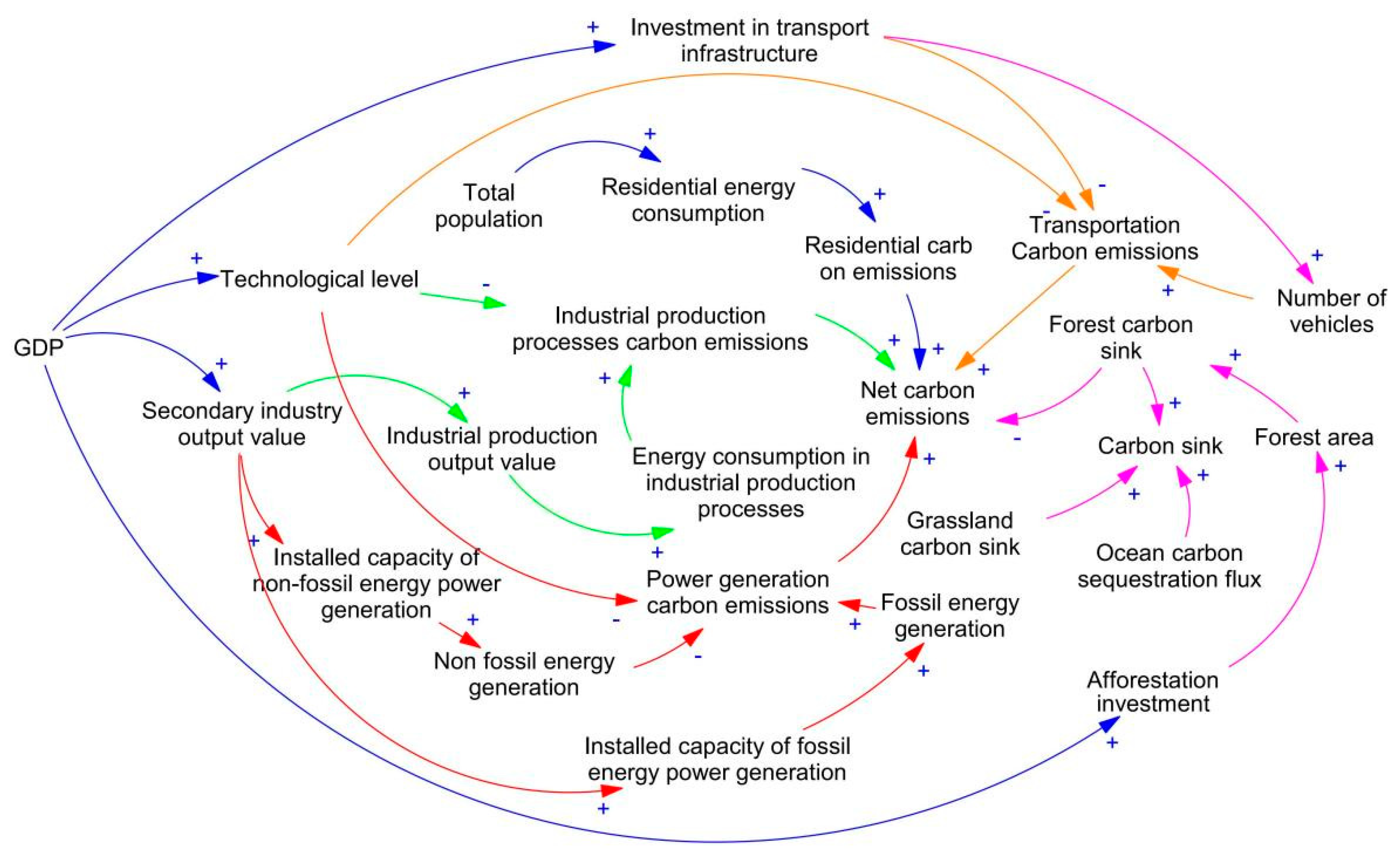
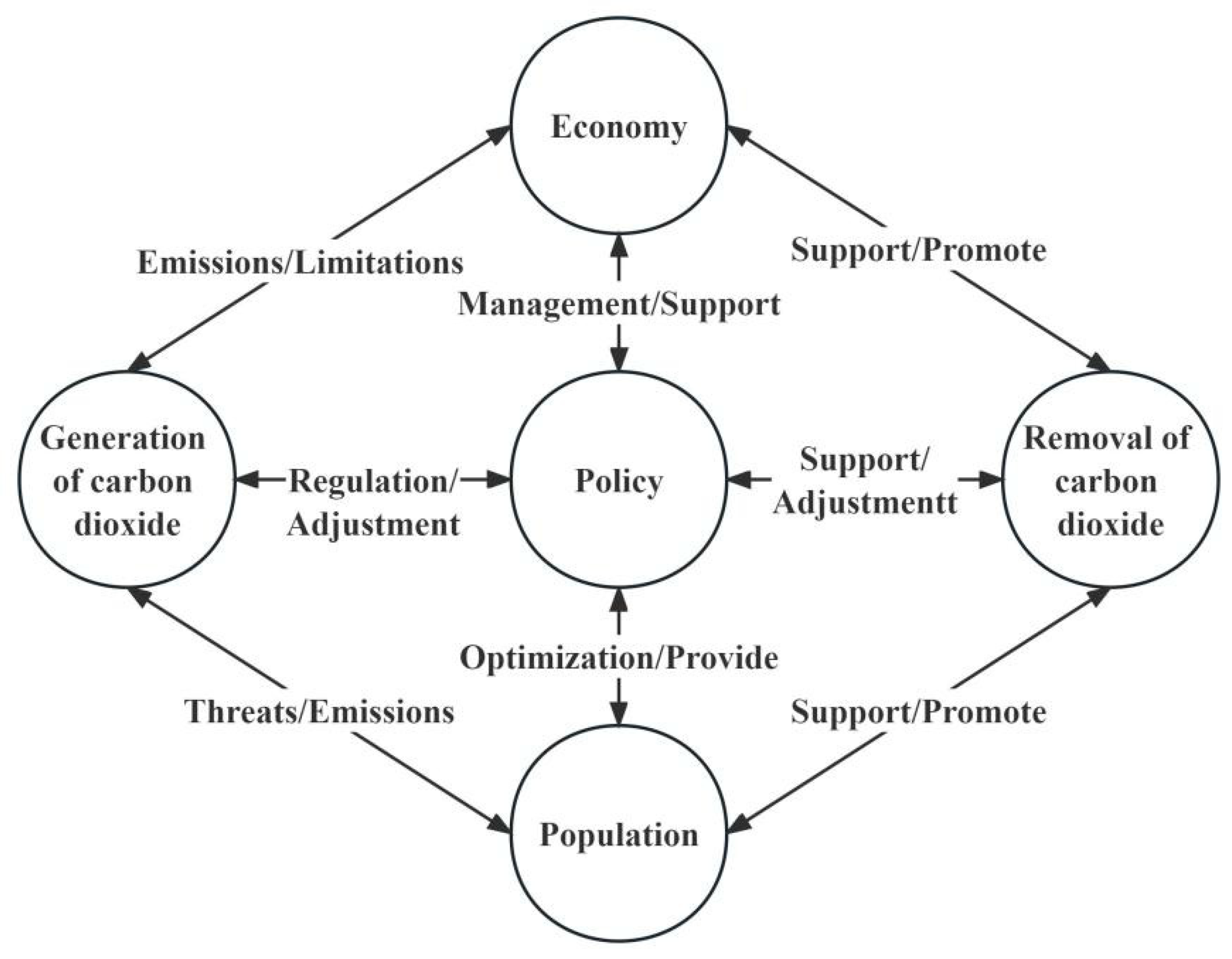
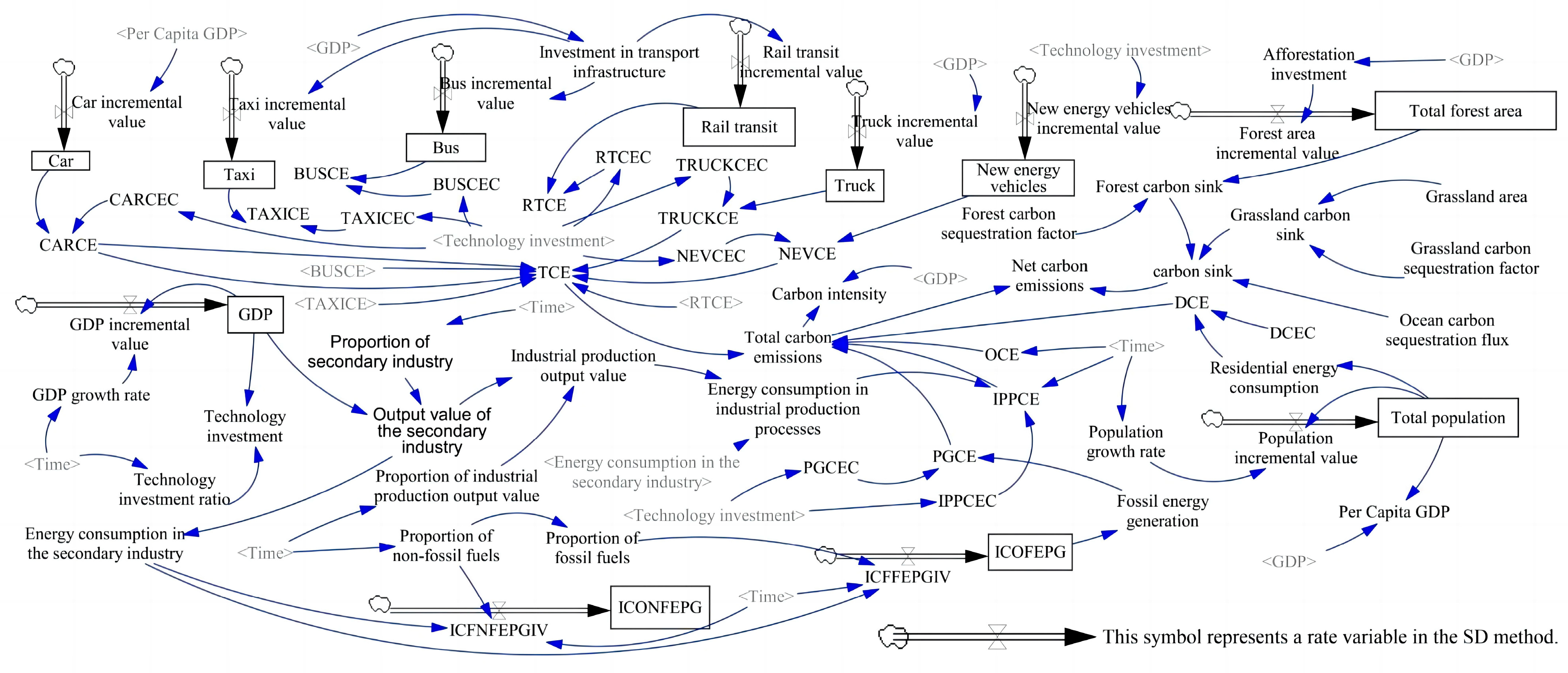
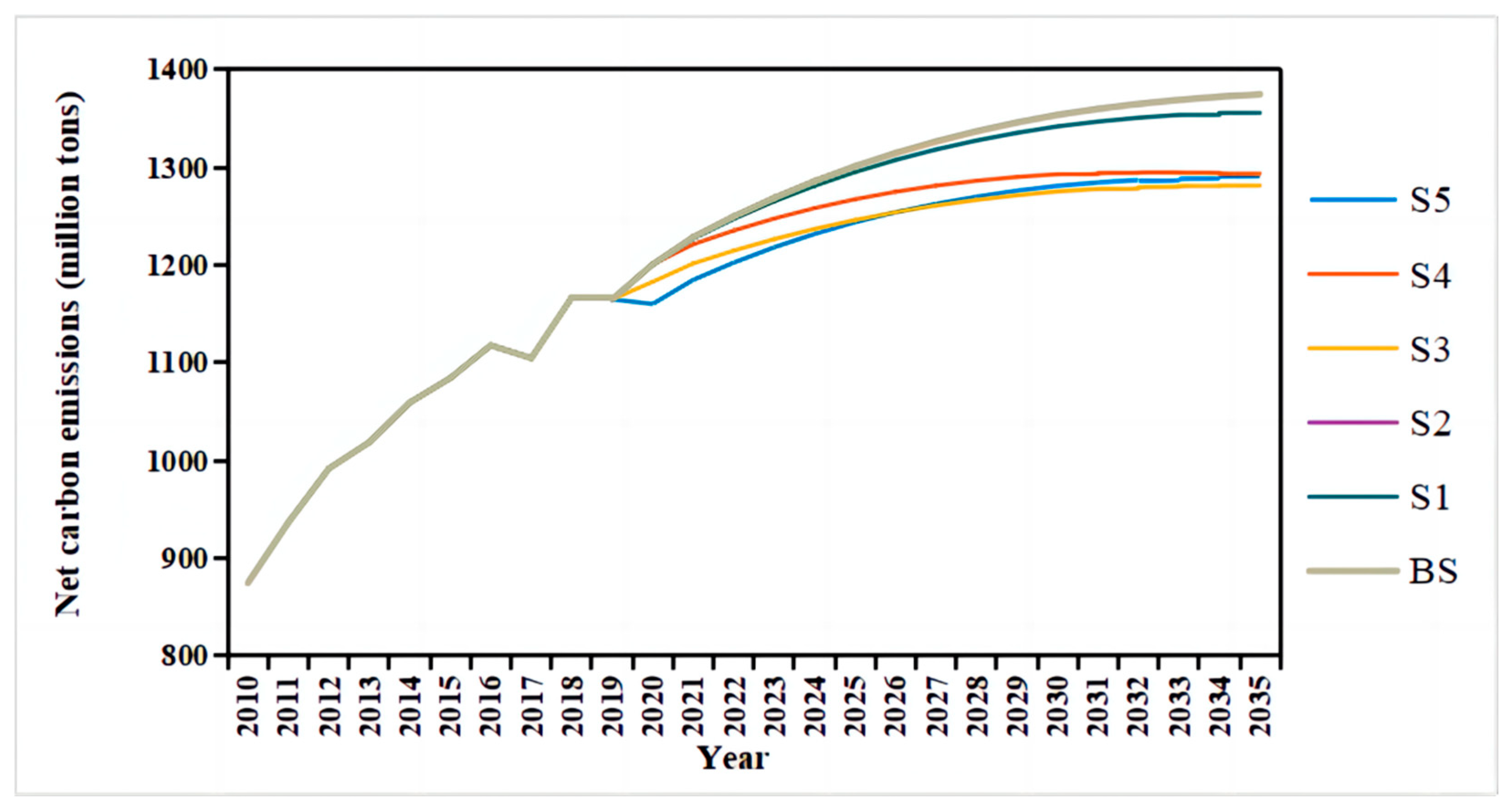



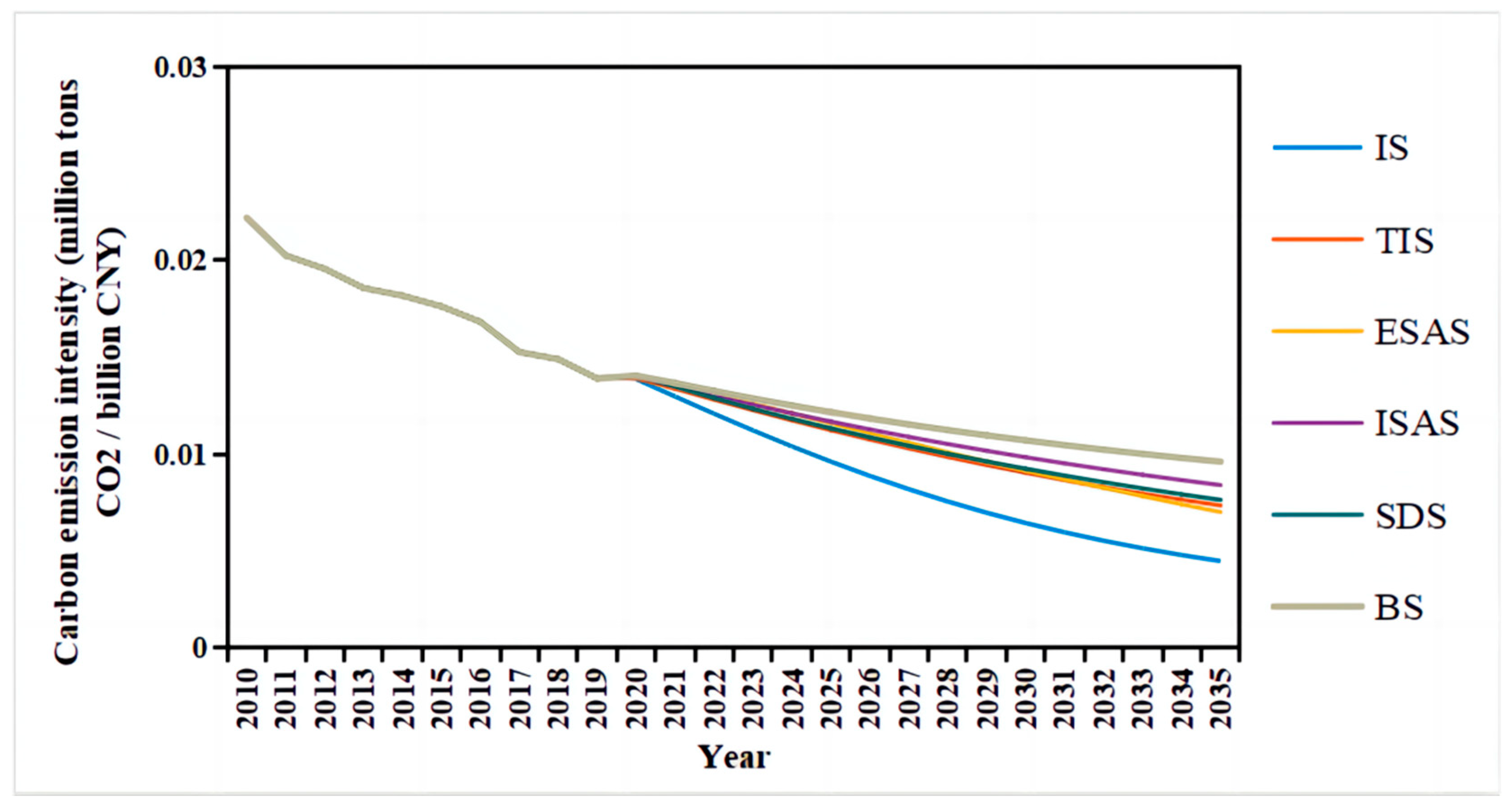
| Variable | 2010 | 2011 | 2012 | 2013 | 2014 | 2015 | 2016 | 2017 | 2018 | 2019 | |
|---|---|---|---|---|---|---|---|---|---|---|---|
| GDP (1010 CNY) | Historical value | 398.0 | 466.9 | 511.5 | 553.4 | 587.8 | 620.6 | 669.9 | 729.7 | 789.6 | 844.8 |
| Simulation value | 398.0 | 466.9 | 511.5 | 553.4 | 587.8 | 620.6 | 669.9 | 729.8 | 789.6 | 844.8 | |
| Relative error (%) | 0.00 | 0.00 | 0.00 | 0.00 | 0.00 | 0.00 | 0.00 | 0.00 | 0.00 | 0.00 | |
| Total population (104) | Historical value | 104.6 | 106.2 | 107.7 | 109.2 | 110.5 | 111.4 | 112.1 | 112.5 | 112.7 | 110.2 |
| Simulation value | 104.6 | 106.1 | 107.7 | 109.2 | 110.5 | 111.4 | 112.3 | 113.0 | 113.6 | 114.1 | |
| Relative error (%) | 0.00 | −0.01 | 0.00 | 0.00 | −0.01 | −0.01 | 0.20 | 0.42 | 0.76 | 3.47 | |
| Total carbon emissions (million tons) | Historical value | 926.0 | 1010.3 | 1010.1 | 1076.8 | 1042.8 | 1035.5 | 1046.5 | 1021.9 | 1155.0 | 1160.8 |
| Simulation value | 882.7 | 944.7 | 999.7 | 1026.8 | 1067.5 | 1092.6 | 1126.2 | 1113.2 | 1175.4 | 1173.7 | |
| Relative error (%) | −4.68 | −6.50 | −1.03 | −4.65 | 2.36 | 5.51 | 7.62 | 8.94 | 1.77 | 1.11 |
| Scenario | Description |
|---|---|
| BS | - |
| S1 | GDP growth rate + 10% |
| S2 | Population growth rate + 10% |
| S3 | Proportion of secondary industry − 10% |
| S4 | Proportion of non-fossil fuels + 10% |
| S5 | Technology investment ratio + 10% |
| Scenario | Description |
|---|---|
| BS | Develop according to current policies. |
| SDS | This scenario simulates the situation of economic and population growth. We increased the GDP growth rate to 6.40% in 2020 and slowly decreased it to 3.30% in 2035. Meanwhile, considering the fact that the population growth rate of the BTHUA has been continuously decreasing in recent years, we set the population growth rate from 2020 to 2035 to remain unchanged based on the population growth rate of 0.27% in 2020. The remaining variables were consistent with the BS. |
| ISAS | This scenario simulates the optimization of industrial structure. We decreased the proportion of the secondary industry to 18.00% in 2035. The remaining variables were consistent with the BS. |
| ESAS | This scenario simulates the adjustment of the energy structure. We increased the proportion of non-fossil fuels to 40.00% in 2035. The remaining variables were consistent with the BS. |
| TIS | This scenario simulates the progress of technology. We increased the proportion of technology investment to 5.60% in 2035. The remaining variables were consistent with the BS. |
| IS | This scenario contains all the controls for SDS, ISAS, ESAS, and TIS, with the remaining variable settings consistent with the BS. |
Disclaimer/Publisher’s Note: The statements, opinions and data contained in all publications are solely those of the individual author(s) and contributor(s) and not of MDPI and/or the editor(s). MDPI and/or the editor(s) disclaim responsibility for any injury to people or property resulting from any ideas, methods, instructions or products referred to in the content. |
© 2023 by the authors. Licensee MDPI, Basel, Switzerland. This article is an open access article distributed under the terms and conditions of the Creative Commons Attribution (CC BY) license (https://creativecommons.org/licenses/by/4.0/).
Share and Cite
Zeng, Y.; Zhang, W.; Sun, J.; Sun, L.; Wu, J. Research on Regional Carbon Emission Reduction in the Beijing–Tianjin–Hebei Urban Agglomeration Based on System Dynamics: Key Factors and Policy Analysis. Energies 2023, 16, 6654. https://doi.org/10.3390/en16186654
Zeng Y, Zhang W, Sun J, Sun L, Wu J. Research on Regional Carbon Emission Reduction in the Beijing–Tianjin–Hebei Urban Agglomeration Based on System Dynamics: Key Factors and Policy Analysis. Energies. 2023; 16(18):6654. https://doi.org/10.3390/en16186654
Chicago/Turabian StyleZeng, Yuan, Wengang Zhang, Jingwen Sun, Li’ao Sun, and Jun Wu. 2023. "Research on Regional Carbon Emission Reduction in the Beijing–Tianjin–Hebei Urban Agglomeration Based on System Dynamics: Key Factors and Policy Analysis" Energies 16, no. 18: 6654. https://doi.org/10.3390/en16186654




